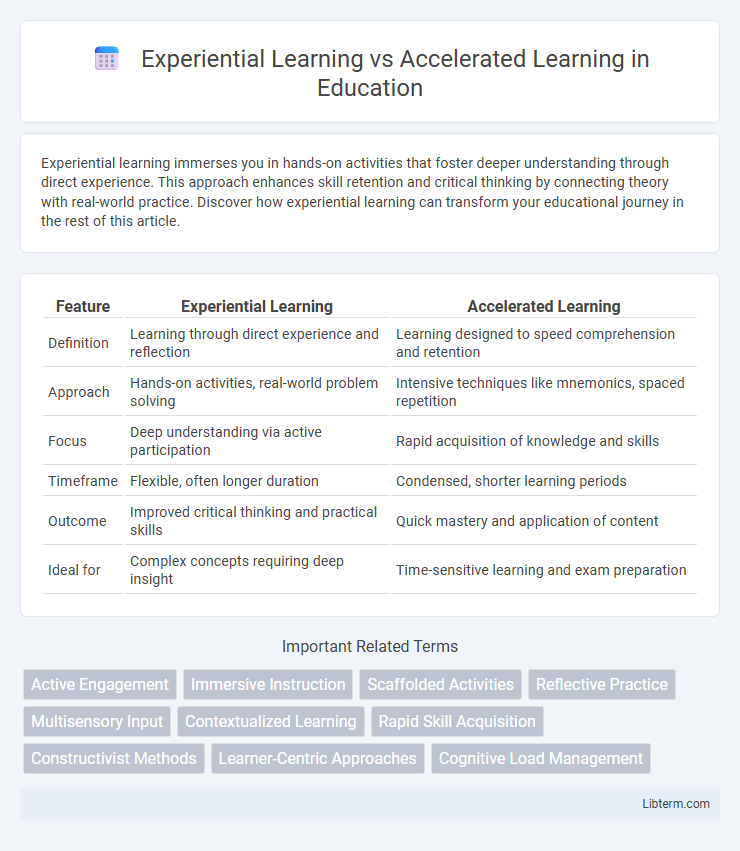Experiential learning immerses you in hands-on activities that foster deeper understanding through direct experience. This approach enhances skill retention and critical thinking by connecting theory with real-world practice. Discover how experiential learning can transform your educational journey in the rest of this article.
Table of Comparison
| Feature | Experiential Learning | Accelerated Learning |
|---|---|---|
| Definition | Learning through direct experience and reflection | Learning designed to speed comprehension and retention |
| Approach | Hands-on activities, real-world problem solving | Intensive techniques like mnemonics, spaced repetition |
| Focus | Deep understanding via active participation | Rapid acquisition of knowledge and skills |
| Timeframe | Flexible, often longer duration | Condensed, shorter learning periods |
| Outcome | Improved critical thinking and practical skills | Quick mastery and application of content |
| Ideal for | Complex concepts requiring deep insight | Time-sensitive learning and exam preparation |
Understanding Experiential Learning
Experiential learning emphasizes learning through direct experience, allowing learners to engage actively with real-world tasks and reflect on their actions to deepen understanding. This approach leverages hands-on activities, simulations, and problem-solving scenarios, fostering critical thinking and long-term retention. By situating knowledge within practical contexts, experiential learning enhances the ability to apply concepts effectively across diverse situations.
Defining Accelerated Learning
Accelerated learning is a dynamic educational approach designed to enhance the speed and efficiency of acquiring knowledge by utilizing techniques such as multisensory engagement, mnemonic devices, and active participation. Unlike traditional experiential learning, which emphasizes hands-on experience and reflection, accelerated learning integrates cognitive science principles to maximize retention and understanding within a shorter timeframe. This method often incorporates strategies like spaced repetition, mind mapping, and interactive activities to facilitate rapid mastery of complex subjects.
Core Principles of Experiential Learning
Experiential Learning centers on the core principles of active participation, reflection, and contextual application, emphasizing learning through direct experience and critical thinking. It aligns with Kolb's experiential learning cycle, which includes concrete experience, reflective observation, abstract conceptualization, and active experimentation to solidify knowledge. This method contrasts with Accelerated Learning by prioritizing immersive, hands-on engagement over rapid information intake, fostering deeper comprehension and long-term retention.
Key Features of Accelerated Learning
Accelerated Learning emphasizes rapid knowledge acquisition through multisensory engagement, active participation, and personalized learning paths, utilizing techniques like spaced repetition and brain-based strategies. It prioritizes creating an optimal learning environment with emotional safety and motivation, enhancing retention and transfer of knowledge efficiently. Key features include chunking information, integration of physical movement, and immediate feedback to reinforce understanding and accelerate cognitive processing.
Benefits of Experiential Learning Approaches
Experiential learning enhances knowledge retention by enabling learners to engage directly with real-world scenarios, fostering critical thinking and problem-solving skills. This approach promotes deeper understanding through active participation, which improves long-term cognitive development and skill application. Learners build practical experience that increases motivation and adaptability, essential for dynamic educational and professional environments.
Advantages of Accelerated Learning Techniques
Accelerated learning techniques enhance knowledge retention by engaging multiple senses and cognitive processes simultaneously, leading to faster comprehension and skill acquisition. These methods utilize active participation, such as spaced repetition, mnemonic devices, and interactive exercises, which improve memory encoding and recall. Moreover, accelerated learning reduces the overall time required to master complex subjects compared to traditional experiential learning approaches.
Major Differences: Experiential vs Accelerated Learning
Experiential learning emphasizes hands-on, real-world experience to deepen understanding through active participation, while accelerated learning focuses on techniques and strategies designed to speed up the absorption and retention of information. Experiential learning relies heavily on reflection and practical application, whereas accelerated learning uses methods such as memory aids, multisensory engagement, and cognitive exercises to enhance learning efficiency. The major difference lies in experiential learning's process-oriented immersion compared to accelerated learning's outcome-driven approach to rapid knowledge acquisition.
Practical Applications in Education and Training
Experiential learning immerses students in hands-on activities that enhance retention and critical thinking through real-world problem solving. Accelerated learning condenses complex information using multisensory techniques, enabling faster mastery and improved cognitive engagement. Combining both methods in education and training optimizes skill acquisition and practical application in professional environments.
Case Studies: Real-World Examples
Case studies illustrate that experiential learning through internships and project-based tasks enhances problem-solving skills by immersing students in real-world scenarios, fostering deeper understanding and retention. Accelerated learning techniques, such as spaced repetition and active recall, have proven effective in corporate training programs by reducing course duration while maintaining high knowledge retention rates. Organizations combining both methods report improved employee performance and faster competency development, confirming the complementary benefits of experiential and accelerated learning.
Choosing the Right Approach for Learner Success
Experiential learning emphasizes hands-on, real-world experiences that foster deep understanding through active participation, making it ideal for learners who thrive in practical and immersive environments. Accelerated learning leverages techniques such as spaced repetition, multisensory input, and cognitive strategies to speed up knowledge acquisition, benefiting learners seeking efficient skill mastery. Selecting the right approach depends on individual learning goals, cognitive preferences, and the complexity of the subject matter to maximize retention and learner success.
Experiential Learning Infographic

 libterm.com
libterm.com